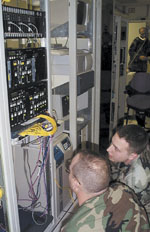Armed Forces Pay Per Use
 |
| The Defense Information Systems Agency (DISA) is using managed services for various network storage, server and other needs. The contracts save the military money on unused capacity and allow it to scale up more quickly to meet emerging requirements. |
The
The Defense Information Systems Agency (DISA),
Traditionally, the military has acquired capital assets such as servers and mainframes. To respond to its customers’ requests, DISA generally issues a request for proposals (RFPs) or uses a contract award then negotiates for the products or capabilities that the client needs. “We had a lead time between the time when the customer asked for the capacity to host an application and the time we could deliver it,” explains John Garing, chief information officer and director for strategic planning and information, DISA.
To reduce the wait, DISA decided to approach the problem in a new way, beginning with a couple of small managed services data replication contracts. The agency then moved on to a larger server and storage contract. “What we care about is having capacity that we can turn on and turn off like you turn on and turn off power, electricity in your home,” Garing says.
DISA leadership wanted service providers to install capacity in the agency’s data center. Under these managed capacity service contracts, or capacity-on-demand contracts, the service provider maintains capital ownership, and DISA pays only for the services it uses. Though vendors retain ownership, the equipment must reside on the floors of DISA’s data centers for security and operational reasons. The arrangement allows DISA to meet the surges in requirements in existing work. The agency can provide capacity to customers more quickly without facing a procurement process each time they want to add more. Additionally, it does not have to maintain extra capacity when demand diminishes. According to Garing, server capacity usage usually is only 20 percent to 35 percent, and storage capacity usage usually reaches only 50 percent. The rest is idle. “That idle is a cost to us,” Garing states. “With the new style contracts, the vendor and DISA share responsibility for the capacity management.”
Capacity on demand is only one type of managed services contract. DISA also acquires commercially managed services available to private citizens or businesses. In July 2006, the agency arranged such a contract with IBM Corporation,
A variation of this type of contract results when a commercially managed service is not totally available, but components exist and can be cobbled together with light integration. To use this type of service, DISA would ask a service provider to combine the elements. Again the provider would maintain ownership of all assets, and DISA would access them as needs require, paying for what personnel use. Instead of approaching an established source for the services required, DISA would arrange for what it needs through another source, most likely a light integrator. In some cases, the government as opposed to a commercial concern may play the role of light integrator.
Garing says that DISA wants to adopt managed services for a number of reasons. The first is to realize the agency’s philosophy to take advantage of commercially available capabilities and not reinvent them. The second is to put those who provide these services for a living in charge of the effort. Garing explains that because these efforts are not core missions or tasks of DISA, the agency would rather have the experts manage the work. The third reason is economic. Because DISA acquires no capital assets, officials are not faced with the inefficiencies associated with owning servers and storage devices running at low occupancy. “There’s not all that idle capacity sitting there at a cost,” Garing shares.
Other advantages include the ability to scale faster by avoiding the acquisition process each time DISA wants to add a service or capacity. “So, this is something we’ve charted a course on and we’re pretty serious about,” Garing explains. “We think it’s faster, cheaper and makes us more agile and responsive to our customers.”
Garing thinks that industry sees the benefits of managed services contracts, though he admits that companies that make money selling hardware, services or components and integrating them might not look on these contracts as favorably as DISA leadership does. However, Garing points out that the opportunities for profit still are available. “The market is still there; it’s just a changing market,” he states. Even small integration companies can provide the managed services DISA seeks. To solicit private industry participants, DISA competes the managed services contracts through the U.S. General Services Administration schedule or through full and open competition. DISA personnel evaluate the proposals and award the contracts.
Garing says that managed services contracts give DISA direct access to the commercially managed services that the organization can locate. DISA is in the process of issuing more managed services RFPs for various needs. The success of the contracts in processing and storage has encouraged DISA officials to consider using managed services in other areas such as communications bandwidth and satellite bandwidth, but the agency has yet to firm up plans in those fields.
Rebecca Harris, director, Global Information Grid Enterprise Services, DISA, shares that the organization soon will issue a request for quote for a second collaboration service to supplement the IBM service currently under contract. Harris explains that DISA requires the two commercially managed services to provide enterprise collaboration capabilities such as audio, video, whiteboarding, instant messaging, file sharing and persistent chat rooms for U.S. Defense Department users. By obtaining both services, users can determine which best meets their needs. Harris says the thought is that each service provider will continue to improve its capabilities to encourage more people to use its product. DISA would pay vendors for usage based on how many people log on.
DISA also is looking at employing managed services for content discovery and delivery needs. This would operate similarly to the way Google and other search engines do but would apply to Defense Department content. Users could search content and ensure that information is delivered as close to them as possible to improve performance.
In addition, DISA plans to provide a service-oriented architecture (SOA) base for managed services contracts. This would comprise a number of functions, including machine-to-machine messaging, service discovery and enterprise service management—the foundational services that will allow the Defense Department to execute SOA.
The last capability DISA will supply is user access to services through a portal. The agency will use the U.S. Army’s Army Knowledge Online as part of the foundation of Defense Knowledge Online. DISA will take advantage of the Army’s portal expertise to offer DISA customers network-centric enterprise services.
DISA leadership says that these new contracts are administered the same way as traditional contracts, but they have posed certain challenges. Both the private and public sectors are determining how to manage the service level, and industry is adjusting to selling services in the new manner. Garing explains that service providers have revenue models based on sending items from the shipping dock rather than providing indefinite services, but he shares that the parties have worked through these problems. He believes that in terms of server and storage capacity, managed services contracts will revolutionize how the federal government obtains what it needs. The contracts give DISA more flexibility and agility and put the burden of service on the providers who have the expertise.
Alfred Rivera, director, Computing Services Division, DISA, says that the managed services contracts in his division have been going well. In some areas they have reduced workload, and personnel can make adjustments in processing ability. The vendor community guarantees that the storage his division might need is available at all times. The Computing Services Division awarded a capacity services contract for all servers in the environment on October 5, 2006.
Rivera’s strategy is to move away from procurement contracts to access managed services. He says that this move is critical to the strategic direction the computer side of DISA envisions. Harris adds that managed services will become widespread throughout the organization because the DISA director’s philosophy is to adopt before buying and to buy before creating. DISA wants to leverage the philosophy to provide capability to its users as quickly as possible. Both the government and commercial aspects of the agency will continue to determine how best to ask for managed services, how to manage them and how to improve them. Harris states that the contracts show that DISA can use and improve existing tools instead of developing products itself.
DISA leaders emphasize that they have committed to managed services and want to realize them to their full potential, expanding them into other areas. Garing asks who can argue against increased speed and reduced cost. “This is the best way to do things. I’m convinced,” he says.
The agency has learned that with respect to writing requirements, a more general statement of objectives can lead to better results. DISA explains what it needs, allowing the commercial providers to use their knowledge and creativity to determine the best methods and solutions in their proposals.
DISA leadership wants to adopt as many services as it can as long as the services meet its needs and security standards. Military troops will benefit from the faster turnaround time without having to worry about what goes on “behind the glass.” The contracts also free up researchers and developers to focus on necessary new products rather than on duplicating what others already have created. This eliminates an opportunity cost the military has been paying.
With all the development in the commercial arena for small services, DISA leaders are keeping an eye on private sector tools that could have government uses. Garing says that the developers of these tools may have had no thoughts about pursuing a military market, but DISA is excited and passionate about bringing those services in and saving the time and resources it would have invested to develop a similar product.
Web Resources
Defense Information Systems Agency: www.disa.mil
IBM Corporation: www.ibm.com
Army Knowledge Online: www.us.army.mil



Comments